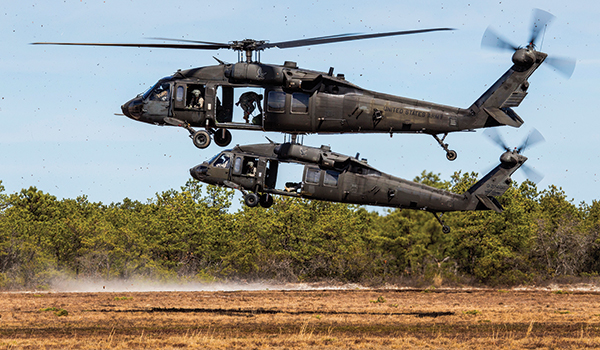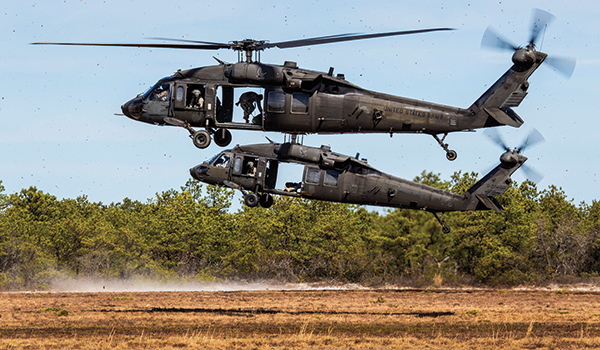
Reserve Components Aviation / By COL J. Ray Davis: Greetings again from your Army National Guard (ARNG). This month I’d like to review where we stand on the major initiatives that Guard Aviation is tackling, as part of the larger Army Aviation Enterprise.

New Jersey Army National Guard UH-60 Black Hawks with the 1-150th Assault Helicopter Battalion participate in a joint training airborne operation at Coyle Drop Zone, Joint Base McGuire-Dix-Lakehurst, N.J., March 12, 2016. / U.S. AIR NATIONAL GUARD PHOTO BY MASTER SGT. MARK C. OLSEN
Aviation Restructure Initiative (ARI)
ARI has been underway for quite some time, and still marches forward, as modified by the National Commission. As of 1 August, the Guard will have inactivated its Air Cavalry Squadron and two Attack-Reconnaissance Battalions (ARBs), and activated a new Assault Helicopter Battalion (AHB). All our Kiowa Warriors are gone, our Apache fleet is down to about 85 aircraft on hand, and our Black Hawk fleet is up to about 882. But, in accordance with NCFA #57, our ARB inventory will remain at 4.
National Commission on the Future of the Army (NCFA)
NCFA had four recommendations that will have an immediate impact on the ARNG:
#34: Conduct a pilot program to test multi-component organizational concepts. Our ground brethren are already implementing such a test, and we’ll follow suit while incorporating their lessons learned. We tried something similar back in the ’80s and ’90s (round-out companies), but we’ve got a different (and successful) experience from OIF and OEF. This experiment may entail increased individual exchanges, multi-component training, and associated units; don’t be surprised if we hit you up to participate.
#57: Retain 4 attack reconnaissance battalions (ARBs) in the ARNG. Although the Army is leaning forward to execute this recommendation, we’re still awaiting final approval (plus approval of our proposed stationing plan). In the meantime, we’ll focus on prepping one of our ARBs for mobilization and deployment sometime in FY18. We expect our ARBs to contribute significantly to the Army’s efforts overseas, so Guard Apache pilots might want to brush up on their Arabic (or German, or Korean).
#59: Increase the flying hours available for peacetime training. Everyone knows this will take more money, but it’s key to implementing the Objective-T concepts and concretely increasing our collective readiness. Where the Budget Genie will go for the funding is still TBD, but this recommendation was reinforced by the Aviation Holistic Review.
#60: Implement a more aggressive modernization program for aviation. The Commission recognized the slow pace of Black Hawk (and Apache) modernization, but this too will take a significant infusion of funding.
Holistic Aviation Assessment Task Force (HAATF)
The Holistic Review released its report in early June, with some significant recommendations with regards to the Guard:
#8: Realign and/or consolidate Aviation formations. In 2012, we did a formal Warfight AAR, and its number 1 recommendation was to consolidate, or at least realign, our aviation formations. It was deemed fiscally infeasible at the time, and the effort never took off. However, this Task Force may help push the initiative forward.
#9: Redefine “essential capability” guidance to align with FEMA regions instead of states. We’ll look at this as we tackle #8. Balancing our Warfight preparation (which favors consolidation) with Domestic Operations readiness (which favors dispersion), is a fundamental dilemma for ARNG Aviation.
#10: Provide ARNG brigade commanders, upon notification of sourcing, with requisite command authorities across state boundaries. This addresses another fundamental dilemma for the ARNG. Title 32 clearly puts authorities in the hands of the Governor, but we must do something to increase the influence of the unit commander on his/her unit, as they get closer to mobilization.
#22: Resource post-initial entry rotary wing (IERW) readiness level (RL) progression as part of flight school. Many of our States already do this; it’s clearly the most effective means to progress a new aviator and minimize expenditures.
#23: Align necessary resources with Reserve Component Aviation participation in combat training center (CTC) rotations. Guard Aviation will support up to four CTC rotations annually, and our flying hours distribution model will ensure CTC participants are well-funded.
As you can see – we’ve got a lot going on, and we’re pedaling as fast as we can up in the National Capital Region. Come up and join us in the Aviation and Safety Division; we’d love to have some new blood on the team. I promise you won’t be bored.
Fly Army. Fly Guard.
COL J. Ray Davis is the chief of the Army National Guard Aviation and Safety Division located in Arlington, VA.










